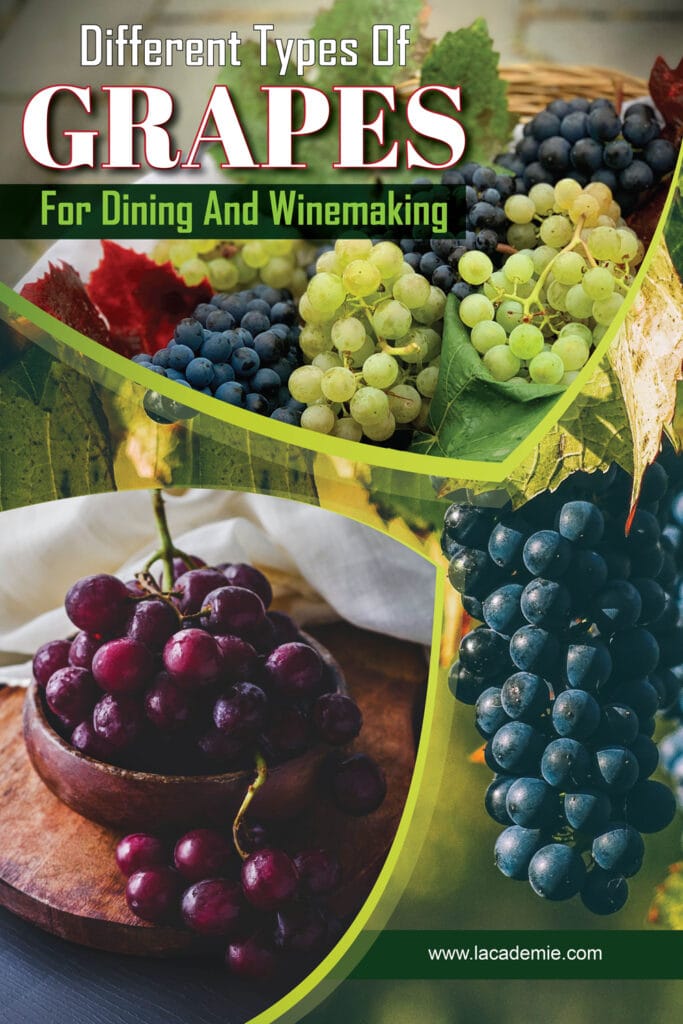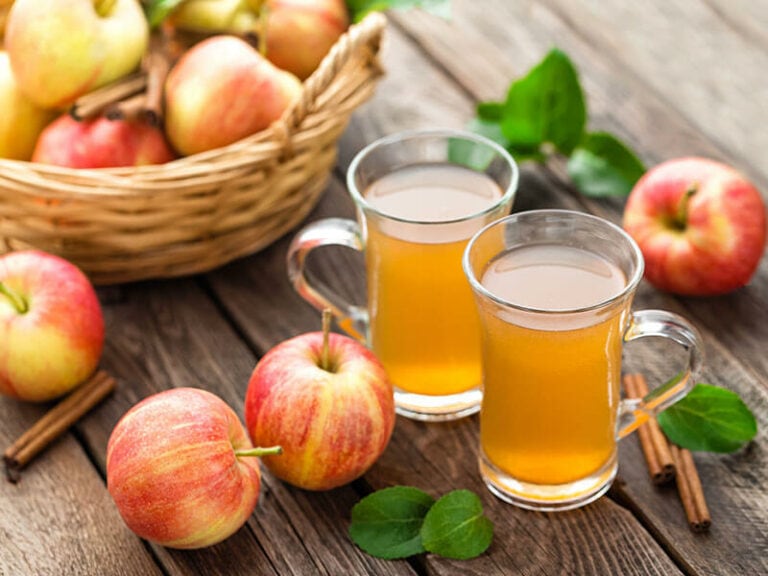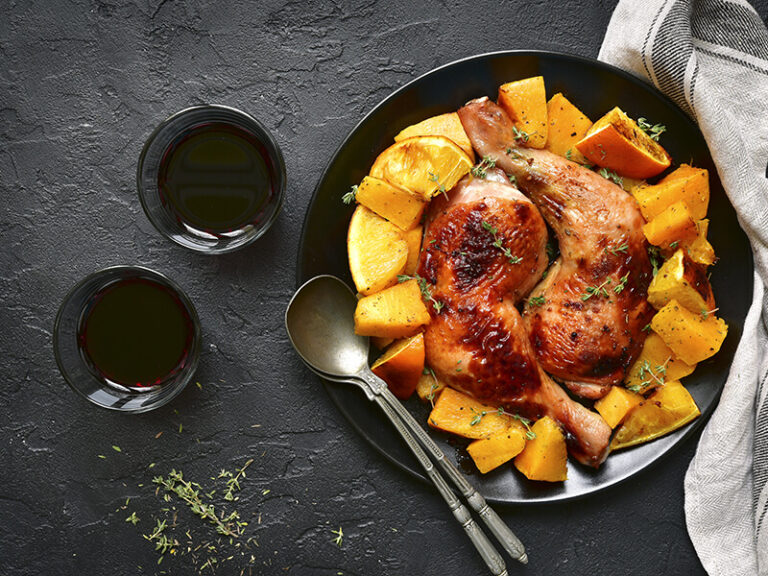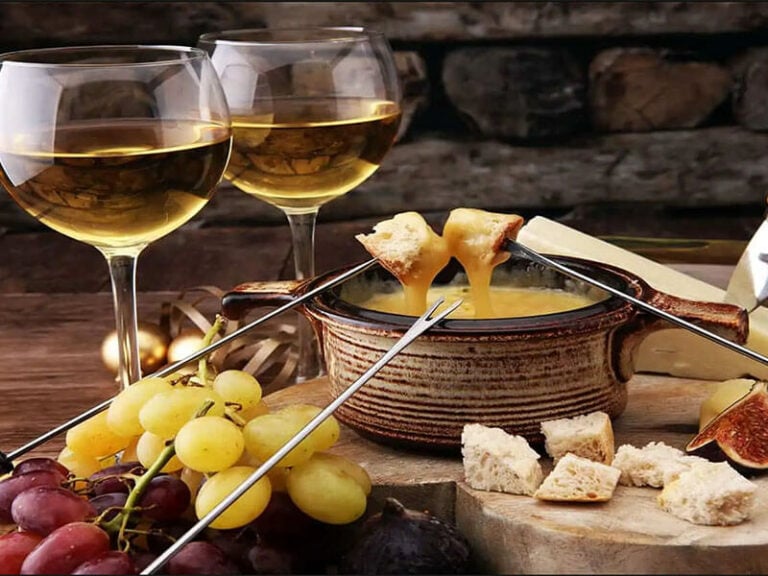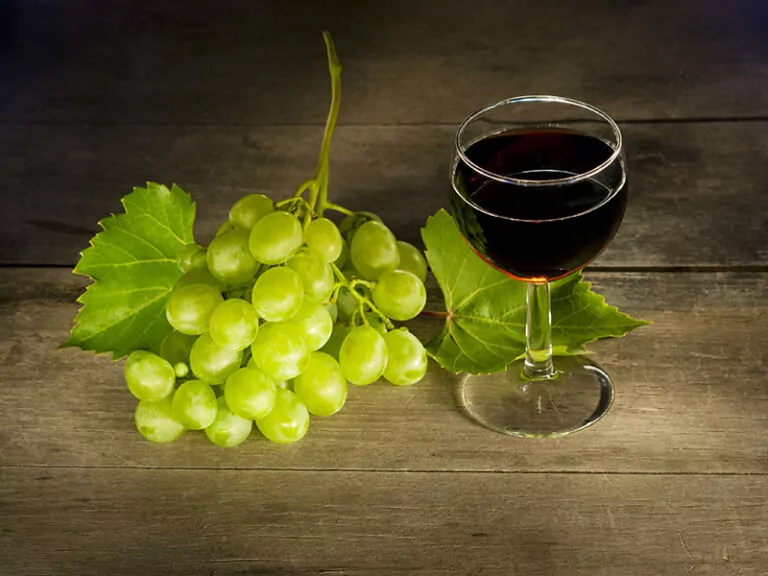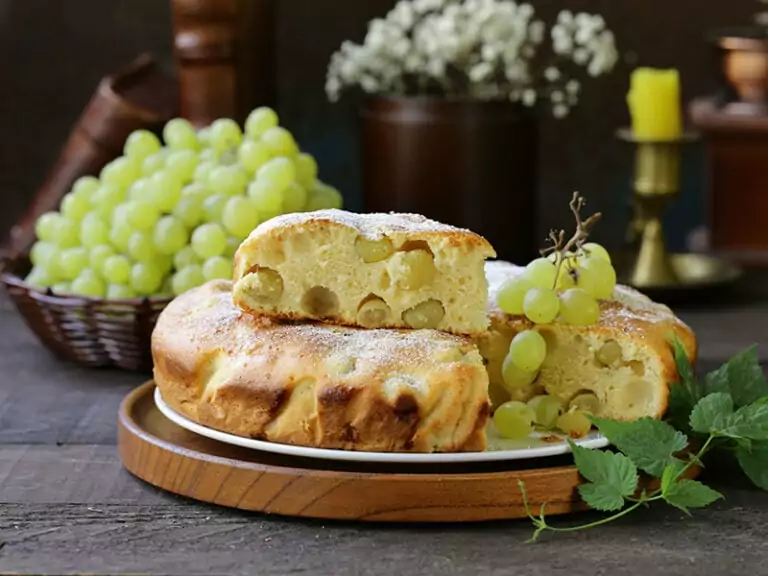There are numerous different types of grapes worldwide, but in this post, I will show you the most popular ones with 27 variations for 2 significant uses: for raw consumption and for making wine.
Grapes are nutritious fruits that many of you love to enjoy as table grapes. However, some variations are cultivated for other culinary uses like making wine, juice, jam, jelly, raisin, or even oil. There are many high-quality grape seed oils that you can buy in the supermarket.
Do you know where the origin of grapes is? Grapes are native to the Middle East, and this fruit has been cultivated for 6,000 to 8,000 years. Today’s grapes are wide in variations with different colors, shapes, and flavors. Read on to discover them all.
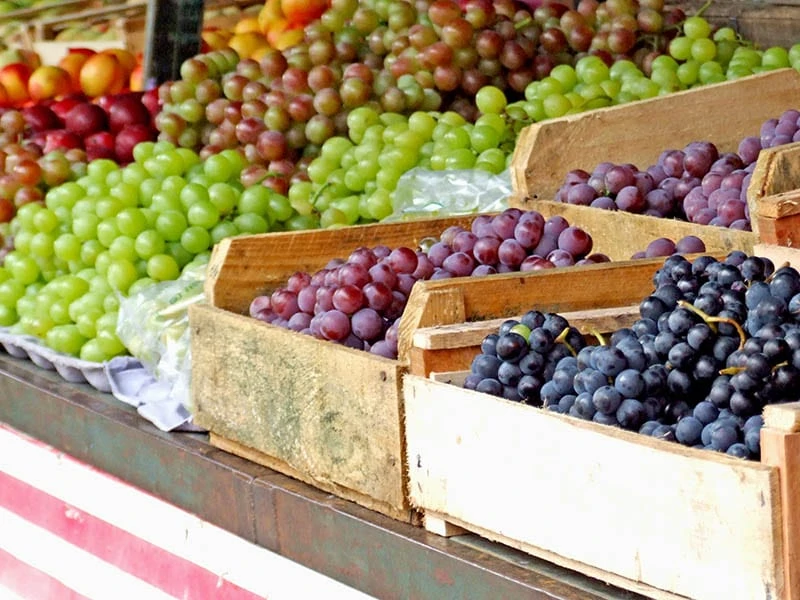
Table Grapes Vs. Wine Grape: What Are Their Key Differences?
The table below will provide you with a quick and reliable way to distinguish between table grapes and wine grapes.
| Characteristics | Table Grapes | Wine Grapes |
| Size | Bigger | Smaller |
| Seeded or Seedless | Most are seedless | Typically have seeds |
| Flesh and Skin | Thicker, crunchier pulp with thinner skins | Thick skin and high-in-juice flesh |
| Level of Acidity and Sugar | Less than wine grapes | High acidity |
13 Well-loved Table Grapes Varieties Around The World
Grapes are a nice fruit to consume fresh on their own, like those table grapes. In this part, I have classified these types of grapes into 3 sections based on their skin color.
There are (1) White table grapes, (2) Red table grapes, and (3) Dark blue/Purple/Black table grapes. The following table will show you some main information about their shapes, flavors, and geographic distribution.
White/Green Table Grapes
There are differences between green and red grapes, so let’s begin the topic with 5 grape types with white or green color. Check them out and see how many varieties you have eaten before.
1. Cotton Candy
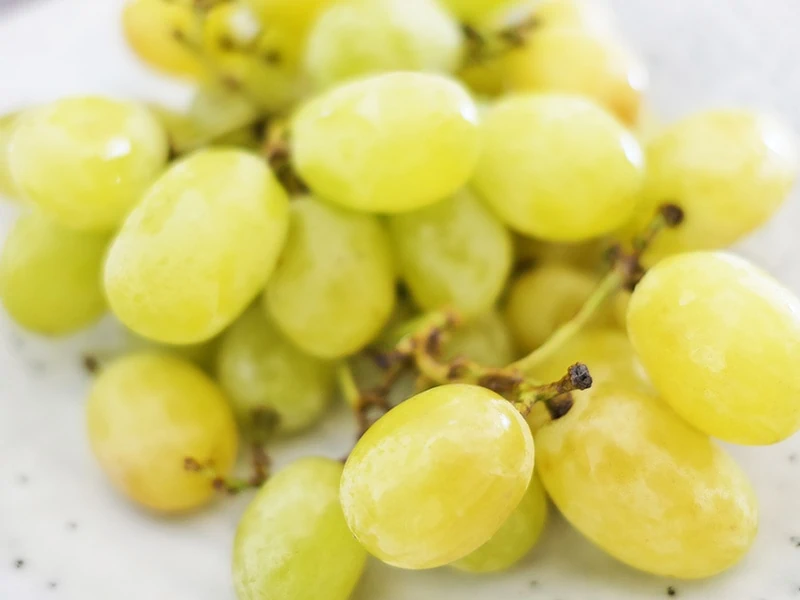
I love the flavor of this grape type since it reminds me of the taste of my favorite childhood candy. So if you like cotton candy grapes, I bet you want to know more about them.
First, this variation is native to California, which was first sold in 2011. The cultivators of this type were David Cain and his co-worker in International Fruit Genetics. They created a grape type with cotton candy flavor without using any artificial flavoring.
Those grapes are medium to large-sized with oblong or oval appearance. Their skin is smooth, firm, and pretty thick. This is a seedless type with translucent green flesh that you can easily buy throughout America at its peak season.
Season: Mid-July to early-September
Location: California (USA), Peru, Chile, Italy, Brazil, South Africa, Mexico, Australia, and Spain
Do you like the flavor of Cotton Candy Grapes? This taste test will tell you more about it.
2. Niagara
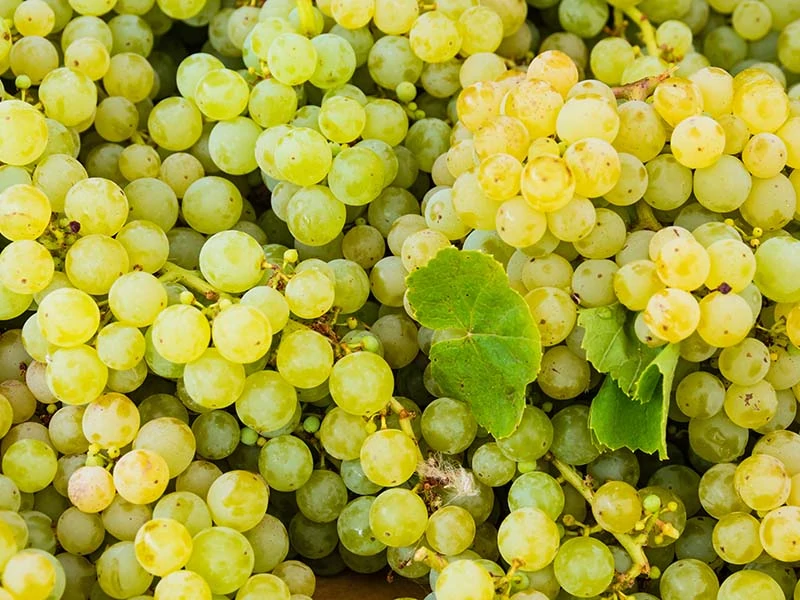
Another American-based grape is Niagara. This is a type of North American species belonging to the Vitaceae family. In fact, they work fine as table grapes or for winemaking. People also use them to make juice and jam.
They are also large with round or oval shapes. Their aroma is nice with a sweet (sometimes tart) taste. There is a purple version of this type, called Pink Niagara, which you can find in the south of Brazil, particularly in São Paulo state.
This is a seedless grape with green skin. They are also the leading green grape in the USA to make white juice. And if you want to make other flavorful drinks with them, there are many recipes to mix apple cider vinegar and grape juice. So let’s make some this weekend!
Season: Late August to early September
Location: New Jersey, Washington, New York, Michigan, Ohio, Pennsylvania (in the USA), Ontario in Canada, New Zealand, and Brazil
3. Moon Balls
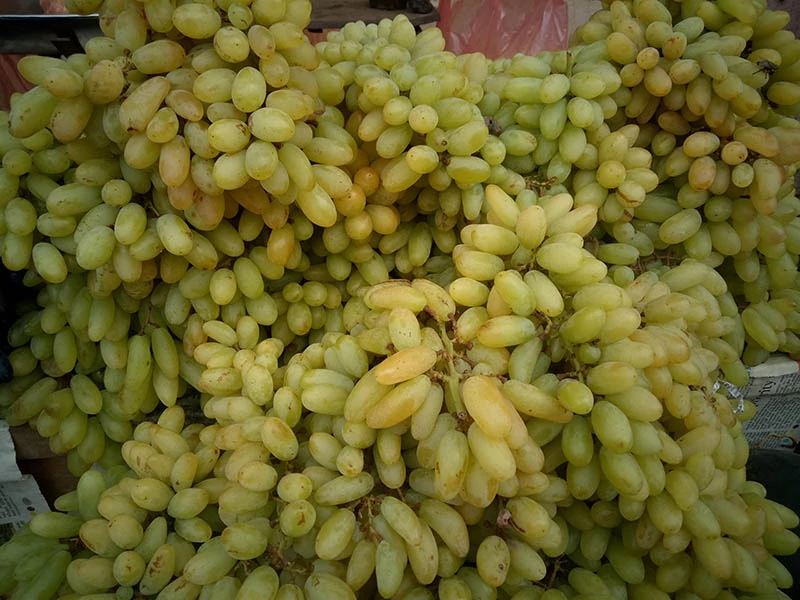
The next white grape is Moon Balls. This is a large-sized grape with white firm flesh and seeds. And if you crave a sweet-flavor grape, Moon Balls might become your favorite type.
However, as they are only grown in South Africa, you can barely find them in your local markets. For now, at least. The skin of Moon Balls is quite thick, but the flesh is superb plump and juicy, making them a perfect table grape.
Season: From February to March
Location: South Africa
4. Perlette
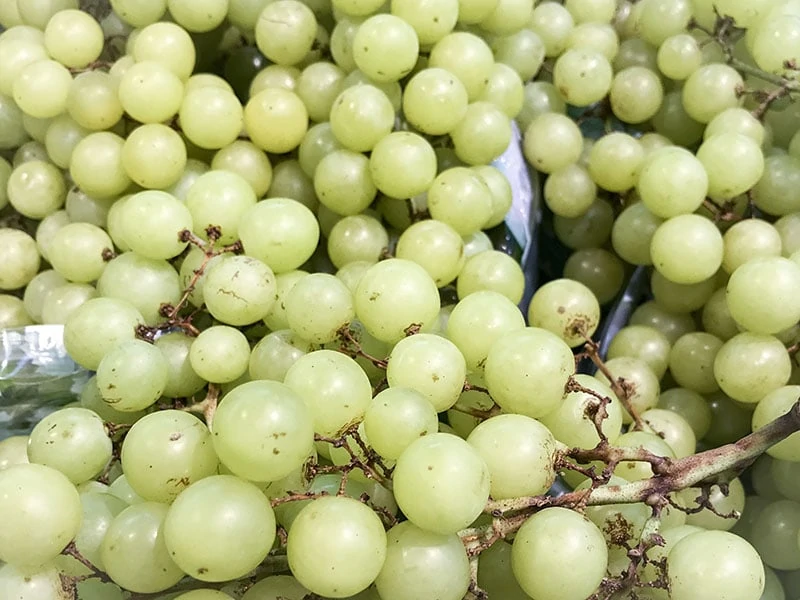
Perlette is a famous seedless grape in European countries. They require well-drained soil and full sun to grow. Besides being an excellent table grape type, it is also ideal for making raisins.
On the other hand, Perlette is a big grape with thin white skin. Many people claim this type is pretty similar to Thompson Seedless, another California white grape. However, this fruit can develop in a wider range of climates compared to Thompson Seedless variation.
What makes them a good type for eating as their flesh is sweet, juicy, firm, and pretty crisp. They are also seedless, so you can conveniently enjoy them at home.
Season: From mid-July
Location: France, Italy, Spain, Austria, Croatia, Portugal, Romania
Check this instruction to choose the best Perlette grapes.
Red Table Grapes
If your favorite color of grape is red, this section is ideal for you. With the 5 below types, you can have more choice in choosing your best-loved grapes for a healthy snack.
5. Red Globe
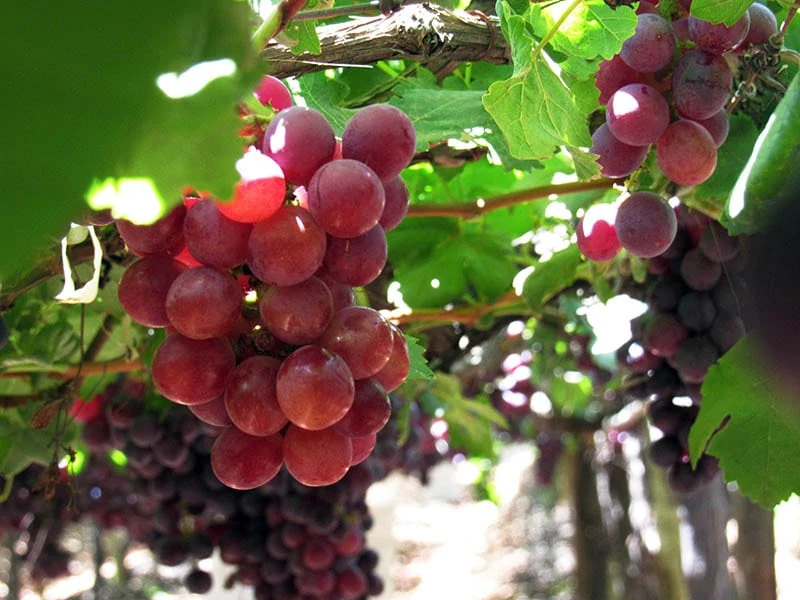
Red Globe is an extra-large size grape that you can either use fresh or dry to make tasty raisins. If you are looking for a fantastic grape for preparing a cheese board, this one can go well with other ingredients like crackers, sausages, and cheeses.
Another fun use of this grape type is you can use it to make frozen ice cubes to make your summer drinks taste even better.
Red Globe grapes have firm flesh with seeds. They can thrive well in warm to very warm places, like Chile, Australia, or California. In the USA, these grapes have been cultivated by Hronis Ranch – a family-owned company that has grown and distributed this high-quality grape since 1945.
A large number of high-quality Red Globe grapes grown in Australia and America are exported to Asian countries, especially Japan, where people welcome them warmly.
Season: July to January
Location: California, Australia, and Chile
6. Crimson Seedless
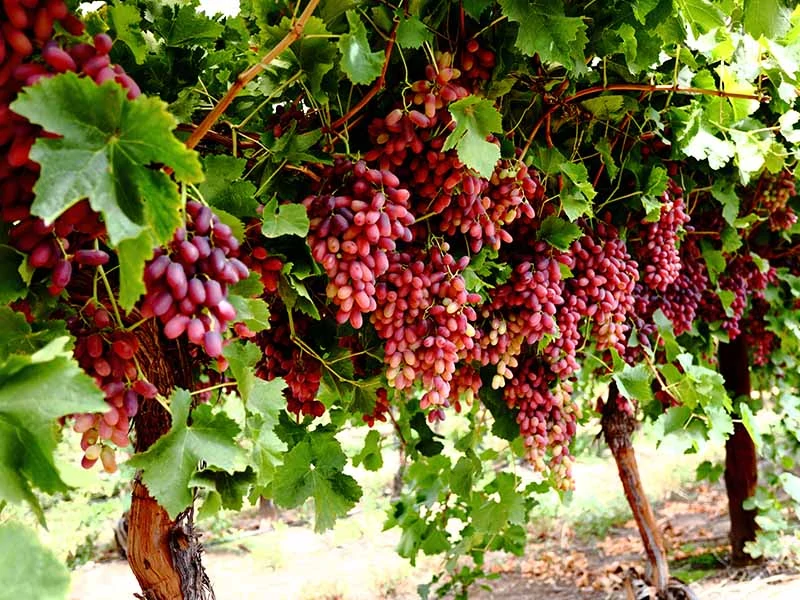
Crimson Seedless is the product of David Ramming and Ron Rarailo in California. This variety was introduced to the public in 1989. Many late-season grapes that you usually find in the winter belong to this type.
These seedless grapes have a bright red appearance with large oval sizes. You will also love the firm and crisp flesh. Besides their sweetness, you can taste a bit of tartness after 1 bit. However, their skin is quite tough and thick, making it better to keep the juiciness inside the skin.
Season: Ripen in the middle of September and can hand on the grapevine through mid-November
Location: California (with around 8,00 acres in San Joaquin Valley)
Check here to know what the Crimson Seedless grapes taste.
7. Ruby Seedless
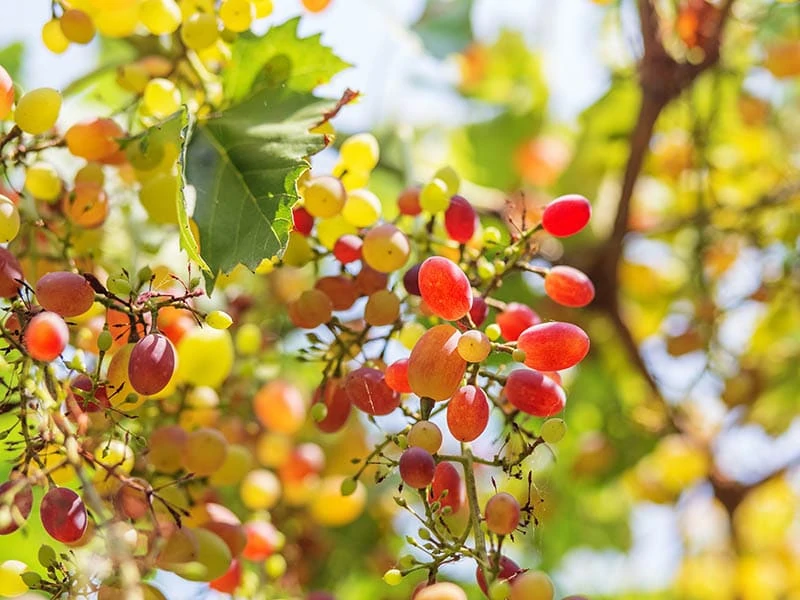
Ruby Seedless is a small to medium-sized dessert grape with an oval shape that grows in large clusters. They feature red to dark red colors, which also own a perfectly crisp texture and sweet taste. Therefore, they are so enjoyable to consume fresh.
This is also a good choice to make raisins. If you want to grow them at home, ensure the weather is warm for them to bear the sweetest fruits. They can grow to form a sturdy arbor, fence, or over the pergola, as long as they are under the full sun.
Ruby Seedless ripens from mid to late-season. This is a hybrid of I.P 75 (from Thompson Seedless and Muscat of Alexandria grapes) and Emperor, which David Ramming (from the University of California) created.
Season: Mid to late season
Location: In the USA, especially inCalifornia
8. Flame Seedless
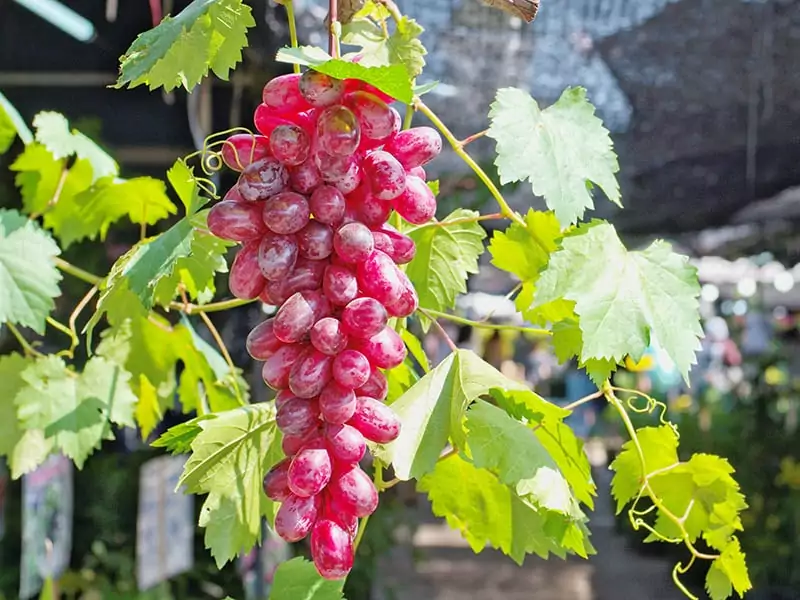
This variation is a close relative to Crimson Seedless, which also shares some similarities with this grape type. First, it is about color. Flame Seedless has a pink to red appearance, but they look rounder than the Crimson Seedless ones.
These grapes also have a balanced sweet taste with a crunchy flesh. They are heavy-bearing grapes that are mixed from Cardinal, Thompson Seedless, and other cultivars in the Vitis vinifera grape family.
In 1973, John J. Kovacevich brought this grape to America. Vulnerable to cool or damp regions, it is mainly grown in Fresno, California.
Season: Start to ripen from August
Location: Fresno, California
Wanna know how to harvest Flame Seedless grapes correctly? Click here to find out.
Black/Purple/Dark Blue Table Grapes
The last section of table grapes captures the other colors, including black, dark blue, and purple grapes. So let’s see how many there are.
9. Kyoho
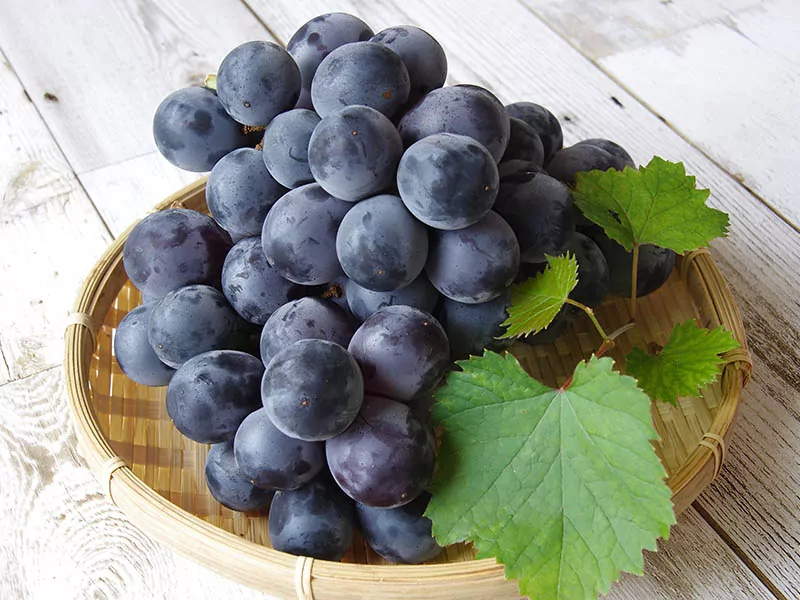
Kyoho grapes are a large variety with an oval shape and blackish-purple smooth skin. They are very famous in Asian countries, particularly in the eastern areas, like Taiwan, Korea, Japan, and China.
In the 1930s and 1940s, their first appearance was introduced by Yasushi Ohinoue – a viticulturist. And they are a combination of some Vitaceae family varieties. Moreover, the word “Kyoho” means “big mountain peak” to indicate the famous Japanese mountain – Fuji.
Kyoho grapes are well-loved thanks to their juicy, soft, and sweet flesh. However, ensure that you remove the skin before consuming it as it might taste a bit bitter. And you need to know the right ways to store your grapes since the Kyoho cultivar is an expensive type.
Luckily, this grape is slip-skin type, allowing you to peel their skins easily. Moreover, the seeds are also bitter, so please discard them as well. For more information, 60% of Kyoho varieties are seedless in Japan. Another way to consume them is in the form of juices or candies.
Season: June to September
Location: East Asia, especially Japan
10. Moon Drop
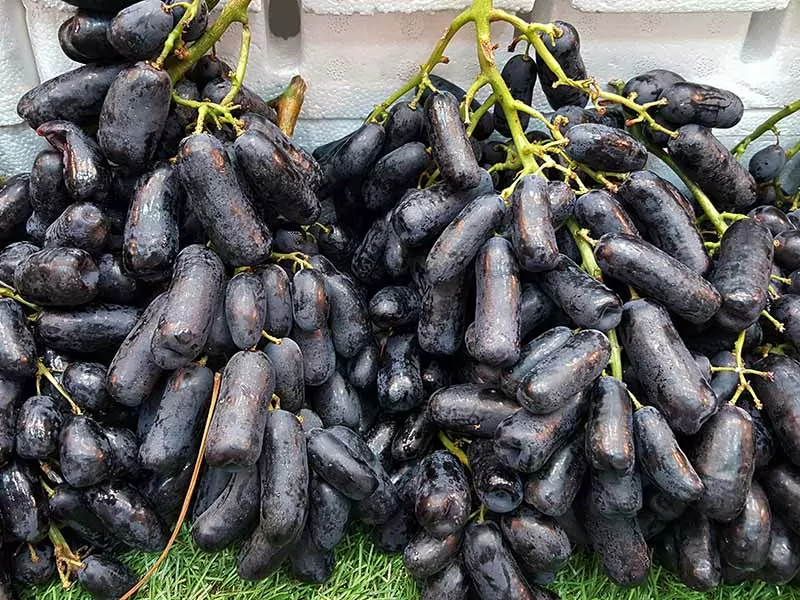
Moon Drop grapes have a special shape that you can easily tell apart from other types. They own an elongated body with a tubular shape and dark blue skin. Moon Drop is also a favorite type in the Southern San Joaquin Valley, California.
These special fruits in black are so crispy that you can even break them into 2 pieces with your fingers. Under the smooth skin is seedless succulent pulp with a naturally sweet taste. In fact, they are sweeter than other black grapes.
Obviously, they are best for fresh consumption or other culinary purposes. You can buy them in many groceries or supermarkets throughout the USA. However, their season is quite short, which occurs from August to November, so please note this time for easier buying.
Season: August to November
Location: Southern San Joaquin Valley in California
Are Moon Drop grapes delicious? This review will give you the answer.
11. Valiant
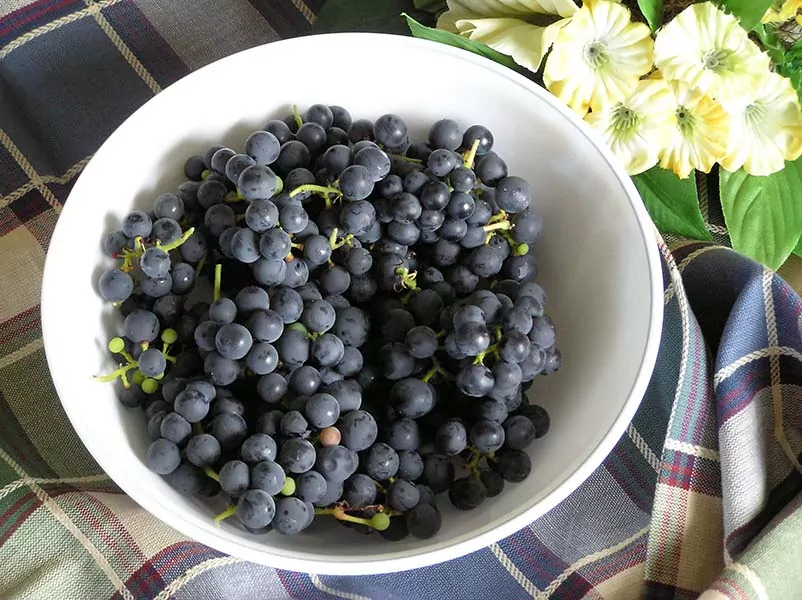
The above types are mostly the warmer-climate grapes, so let’s change the tone of this post with this cold-resistant grape – Valiant.
The medium-sized Valiant variety is the product of South Dakota State University. It is specially made for growers in the North and can withstand the cold weather excellently.
Valiant grapes are bursting with sweet and tangy flavors. The blue skin color always makes them so eye-catching and appetizing. Enjoy them in their fresh form, or you can use them to make juice, jam, wine, or any baked good. But remember that each grape has a few seeds.
Season: Late August to mid-September
Location: Alaska, Canada (best grow in cold weather)
If you want to grow the Valiant at home, do not miss this demo.
12. Concord
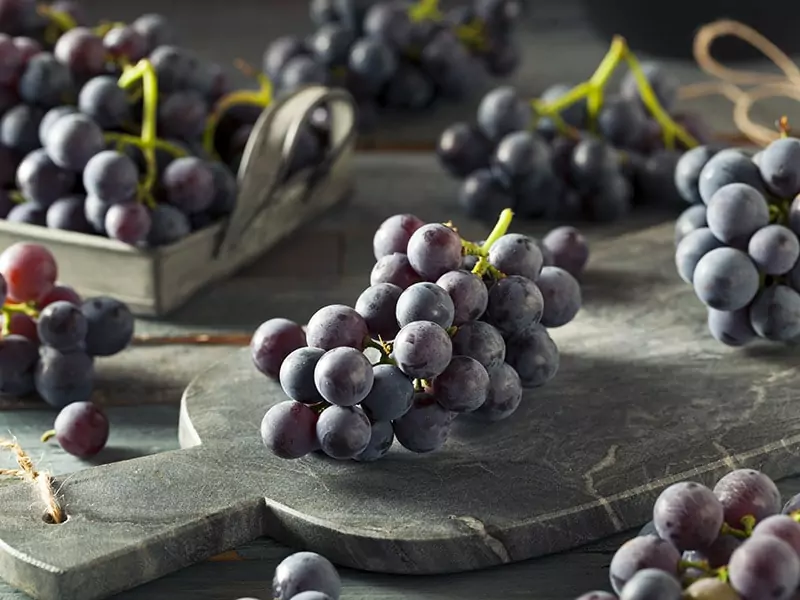
Concord is actually a versatile grape since they are not only a perfect table grape; they can be used to make jelly, juice, or any tasty grape dessert, such as pies and candies. Sometimes, people also use it to make wine, like Kosher wine.
The name of this grape is taken after the Concord town in Massachusetts, which is also the place where people developed this variation. On the other hand, others also claim Concord grapes native to New England.
Like Kyoho ones, these grapes are slip-skin type so you can remove their dark blue skin from the pulp easily. There are 2 main smaller varieties of Concord, including seedless and seeded ones. They also have a very nice sweet flavor with a slight tartness to balance the sweetness.
Season: September to late October
Location: Washington (the Yakima Valley), Lake Erie, the Finger Lakes District of New York, Lake Ontario, the Southwestern part of Michigan
What are the health benefits of consuming Concord grapes? Check it out, guys.
13. Muscadine
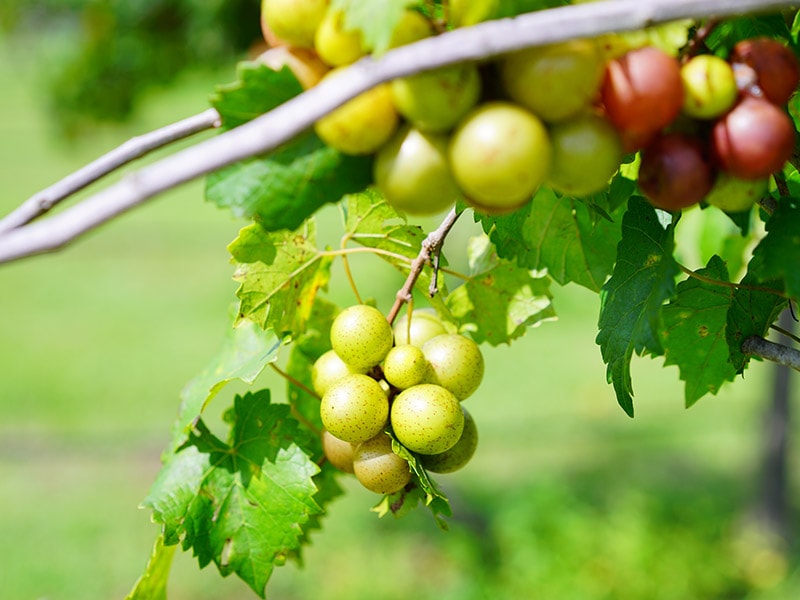
Muscadine grapes (or Vitis rotundifolia) is a special seedless grape from the south of the United States. Their colors range from bronze to dark purple with a large round shape. Moreover, the best climate to grow this variation is in hot weather.
You can easily spot them in North Carolina from late July to early October. However, the harvest season might be a little bit different from state to state.
This variety has been cultivated since the 16th century. Nowadays, its location spreads from Florida to New Jersey or Oklahoma and Texas. Muscadine grapes have around 152 smaller species that are also grown in the Southern parts of America.
They have thick skin full of flavors and nutrients. People can eat them directly, or use Muscadine to make artisan wine, jelly, and juice. Have you ever tried any vodka mixed with grape juice ideas before? If not, do not hesitate to try them soon.
Season: Late July to early October (but still depending on the growing zone)
Location: From Southeastern to South-central of America, Western to Eastern Texas, Florida, Oklahoma, and New Jersey coast
14 Excellent Grape Variations For Winemaking That You Might Not Know
The next part is about the popular grape types that people use to create the finest wine in the world. Check the below chart for quick information.
What Are The Best White Wine Grapes?
In reality, the list of high-quality grapes for white wine is abundant, but here are the top 7 variations to make the top-class wine in the world.
14. Riesling
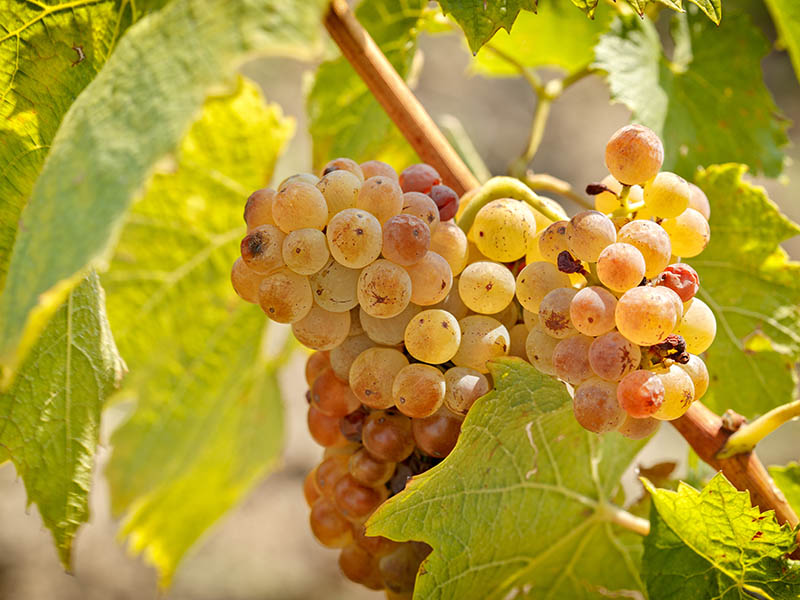
Born in Germany, particularly the Rhine region, Riesling is famous for its nice floral smell and high level of acidity. That’s why they are perfect to create from dry to sweet, or sparkling wine. And these wines can complement your favorite European dishes and make them so mesmerizing.
Today, this type is in the list of top most-grown 20 cultivars with 48,700 hectares. Moreover, Riesling is also in the top 3 white wine grapes, besides Sauvignon blanc and Chardonnay. They are one of the hardiest types that can develop in cool weather, like in the German wine regions.
In this country, they are easily spotted in Pfalz, Mosel, Nahe, and Rheingau regions. But you can also find them in other European countries like France, Austria, Italy, etc. Outside the continent, this variety is grown in Canada, Australia, America, and many other nations.
Season: Ripen from late September to late November; some can be picked in late January
Location: Germany, France, Austria, Italy, the USA, Canada, Australia, etc.
What is the Riesling grape, and how has it become one of the best grapes to make wine?
15. Chardonnay
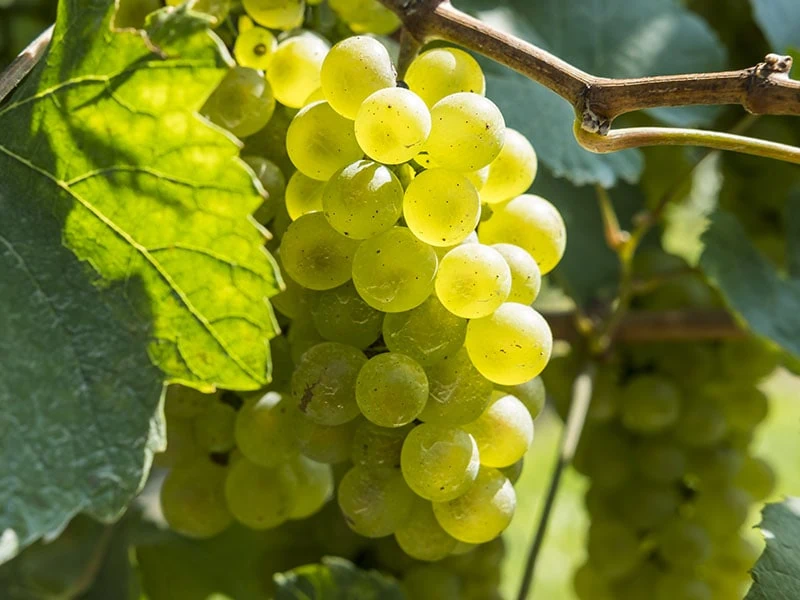
This green-skin grape is native to the eastern of France, in the Burgundy wine area. But nowadays, Chardonnay has spread to other countries like North America, Italy, South Africa, New Zealand, and Australia.
The wine flavor made from Chardonnay varies according to the climate. Grapes grown in the cool weather produce acid, crispy, and lean wine. The perfect example is right in France, where wines have typical fruity and oak tastes.
If they are grown in a medium climate, you can taste the tropical citrus flavors with a sweet touch like honey in these Chardonnay wines, especially in New Zealand (Marlborough region) or Australia.
Season: Mid to late August
Location: Eastern of France, England, New Zealand, Italy, Australia, South Africa
Here is the delightful information about Chardonnay that you should check.
16. Sultana
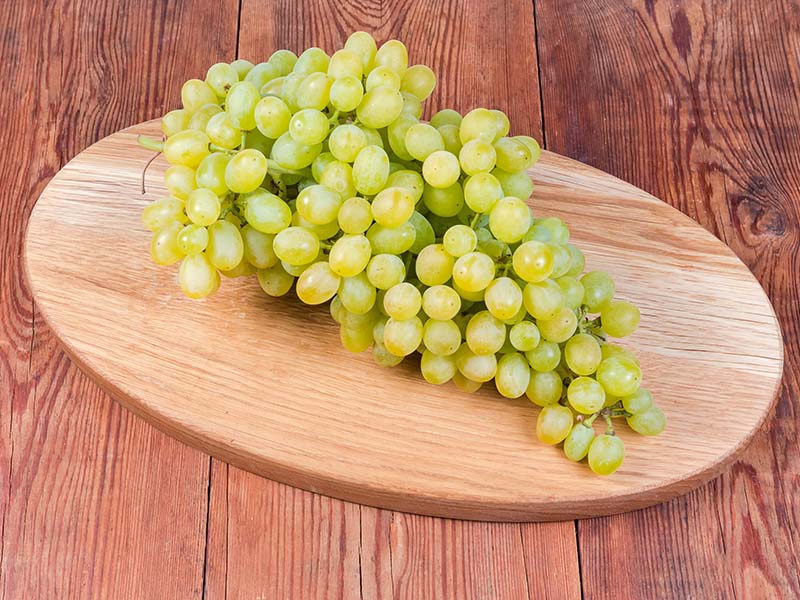
Another light-skinned grape with certain popularity in the winemaking industry is Sultana. In fact, this is the umbrella name to refer to different popular grapes around the world, like Thompson Seedless in the USA, İzmir üzümü in Turkey, Lady de Coverly in England, etc.
These are seedless grape types. Besides winemaking purposes, people also use them to make raisins. Nowadays, the 2 biggest producers of Sultana are Australia and Turkey. But their true origin is still unclear. Some believe this is from the Ottoman Empire era.
Regarding the wine made from them, Sultaniye wines are light-bodied, semi-dry, and dry. Therefore, they have a light sweetness with pleasant fragrances.
Season: Run through September
Location: Turkey (especially in the Aegean Region), Australia, USA, England, etc
17. Pinot Grigio
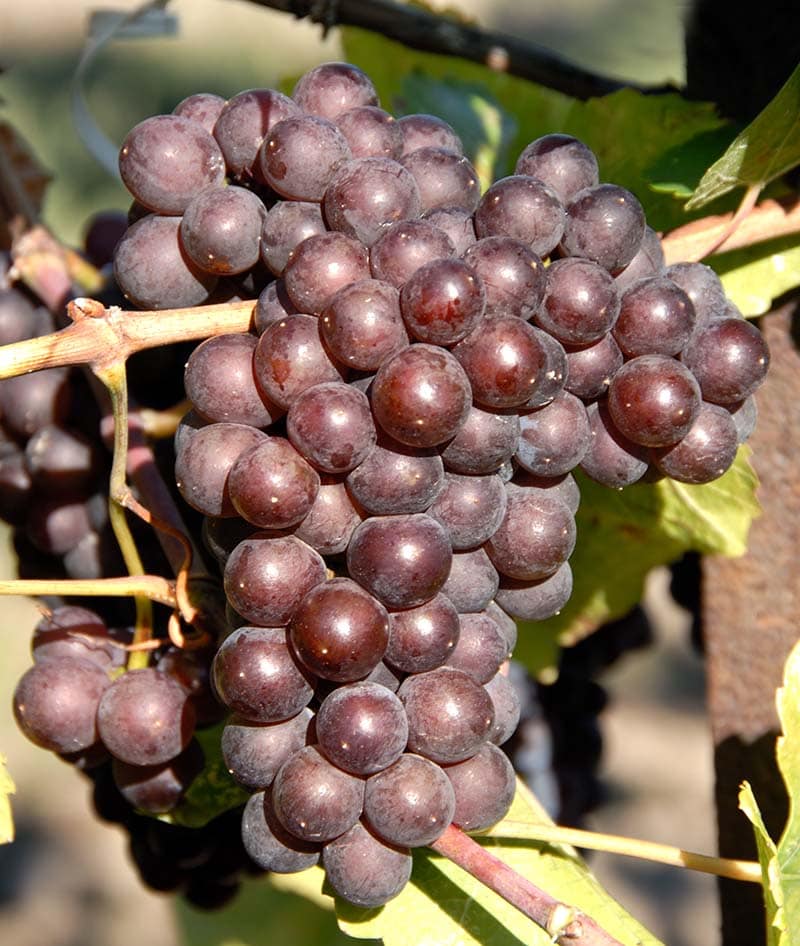
Pinot Grigio originates in the Burgundy region of France, but they are now mostly found in Northern Italy and Alsace region in France with another name – Pinot Gris. This type is well-loved by the zestful acidity and light taste. And pairing them to your hearty Italian dinner is a must.
Many people also claim that they find Pinot Grigio wine tastes are pretty lemony, limey, or citrusy. Their textures are usually silky and smooth, varying from light yellow to dark gold.
Additionally, other nations, like New Zealand, Germany, or Australia, are also successful in growing and making wine from Pinot Grigio.
Season: Harvested from late August to mid-September
Location: Italy (Oltrepo Pavese, Alto Adige, or Friuli-Venezia Giulia), Australia, Canada, Chile, France, Germany, etc.
18. Viognier
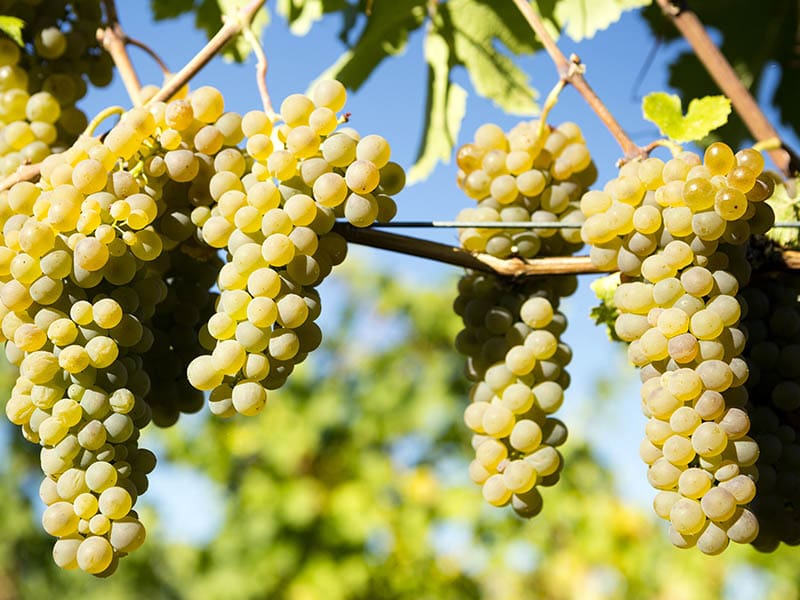
The exact origin of this wine is still unknown, but many people think that they were from Croatia. The Romans brought Viognier to France, including the Rhone Valley. Today, this is the only grape type that Frenches use to make Condrieu wine.
To make the best wine, Viognier grapes should be picked when they are fully ripe. If they are still too young to harvest, the wine’s aroma will decrease and turn a bit oily. However, this plant is too easy to cultivate since its resistance to mildew is not too ideal.
Though Viognier grapes thrive in warm weather with adequate sunlight, they also grow well in a cooler climate. If they are grown and picked correctly, the resulting wine will have fruity notes like pears, peach, and other flavors like minerals and violets.
Season: Harvested from mid to late-August
Location: France, Australia, New Zealand, North and South America, South Africa, Israel, and more.
19. Gewürztraminer
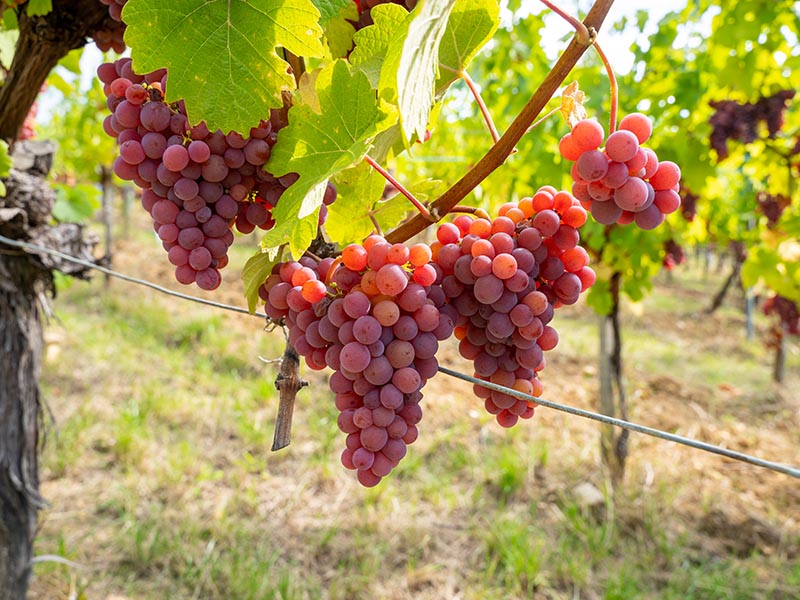
Gewürztraminer grapes are the cool-weather type to make white wines, like the Vendange Tardives from Alsace in France. They have reddish-pink skin with a high level of sugar leading to a deeply sweet flavor.
On the other hand, dried Gewürztraminers have some floral tones, lychee, and rose aromas, and a light touch of passion fruit hint. People also use them to make full-bodied wine in various styles from nation to nation.
Regarding the etymology of the word Gewürztraminer, it means “Spice Traminer” in German. Plus, it is a mutated variety of Savagnin blanc grapes which also have the name Traminer.
Season: Grow from hot spring to summer, harvested from September to November
Location: European countries (France, Italy, Austria, etc.), New Zealand, Chile, South Africa, and more
A short documentary about Gewürztraminer grape is waiting for you to explore.
20. Verdicchio
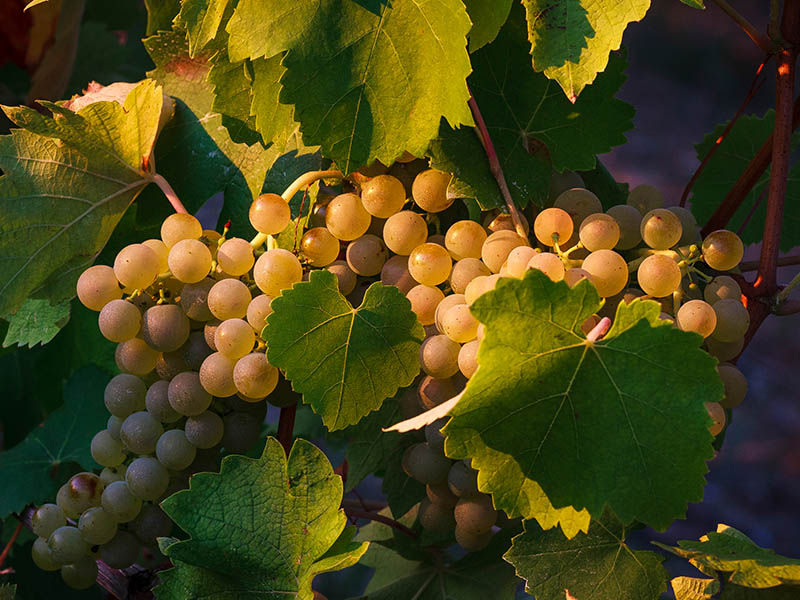
Verdicchio cultivation started in Italy in the 14th century. So if you have been to Italy, you might have tried some wines made from Verdicchio grapes, especially in the Central part of Italy, like the Marche region.
The notable wine products of this type are DOC wines, Colli Pesaresi, Verdicchio dei Castelli di Jesi, etc. They are high-acidity wines with some notes of citrus fruits. Some of them even have lemon flavors along with some light touch of almond.
Season: Ripen in late August in Italy
Location: Mostly in central Italy (the Marche region)
7 Famous Red Wine Grapes Worldwide
The last part is about the finest grapes to make red wine around the world. If you are a big fan of these wines, I guarantee you can gain a lot of knowledge about them by reading this section.
21. Pinot Noir
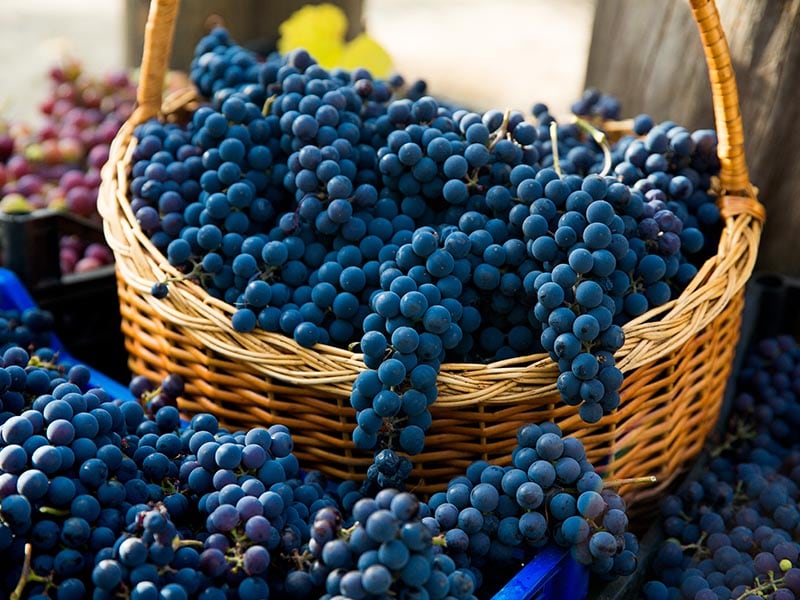
Pinot Noir is the iconic grape to make red wine, like Nuits-Saint-Georges. They belong to the Vitis vinifera species with special black skin.
Basically, this is a worldwide grape cultivar, but mainly in the cool climate regions. Some specific areas to grow it are Great Southern in Tasmania, Willamette Valley of Oregon, Elgin, and Walker Bay regions in South Africa. However, this variety is not an easy one to grow and make wine.
Anyway, the wine flavors change markedly according to the ages of the grapes. For example, young-age Pinot Noir can create various berry flavors in the wine, like strawberries and cherries. But the mature ones can create a more complex taste with a grassy smell.
Season: August to September
Location: Mainly in France (the Burgundy region), California, New Zealand, and other countries
Check here to gain more information about Pinot Noir.
22. Cabernet Sauvignon
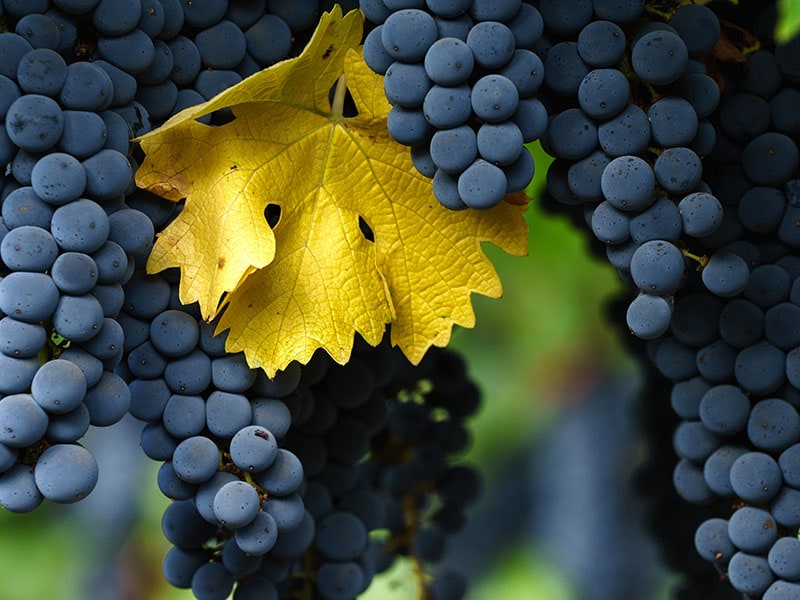
Cabernet Sauvignon is the hybrid product between Sauvignon blanc and Cabernet Franc dating back to the 17th century. It is a popular wine grape thanks to its ease of care and good resistance to grape diseases.
These grapevines are hard, and the fruits’ skin is thick, increasing the resistance to difficult weather and insects. Moreover, the wine characteristics vary based on the different levels of climate.
In the cool climate, these wines have the taste of green bell pepper, cedar, and mint. They are even stronger when the wine gets older. Interestingly, Cabernet Sauvignon wines taste a bit jammy in the hot climate.
In moderate weather, they can carry some hints of black olive and cherry. But the overall profile of these grapes is acidic with high levels of tannin, increasing the possibility of aging.
Season: Mid-August to late October (in Napa Valley)
Location: South American countries, Australia, South Africa, Canada, New Zealand, France, Spain, and more
Why does Cabernet Sauvignon become an ideal grape to create the greatest wine in the world?
23. Shiraz
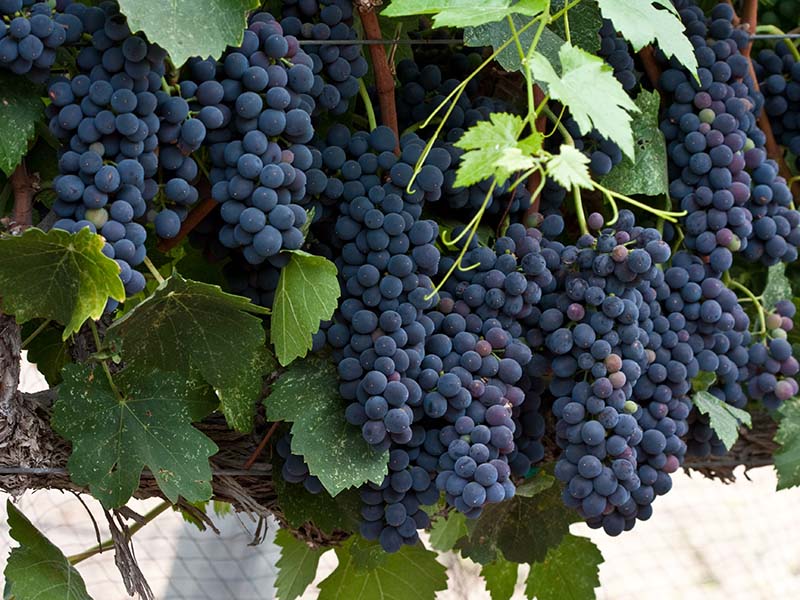
Shiraz (or Syrah) is another well-loved grape to make red wine thanks to its dark skin. Though Shiraz is recorded in the Rhone region in France for a long time, the exact root of this type is still in question.
Moreover, people in some countries like France, New Zealand, Chile, Argentina, and other European countries prefer to use the name Syrah rather than Shiraz. Instead, Shiraz is widely used in Australia.
The overall profile of Shiraz wine is high in acidity, tannins, and hints of dark chocolate and blackberry. However, it is subject to the climate condition in which the grapes are cultivated.
In hot weather (in Australia), you can sense their lighter tannin with some touch of cloves, anise, licorice, and hints of dark chocolate, mocha, and espresso from the full-bodied wines.
But they might have notes of mint, black pepper, eucalyptus, and smoked meat if they are grown in a moderate climate, particularly in the USA and Northern Rhone Valley.
Season: Varied by years but mostly from late October for late years
Location: France, Italy, Spain, Australia, Switzerland, New Zealand, Chile, USA, South Africa, Argentina
24. Merlot
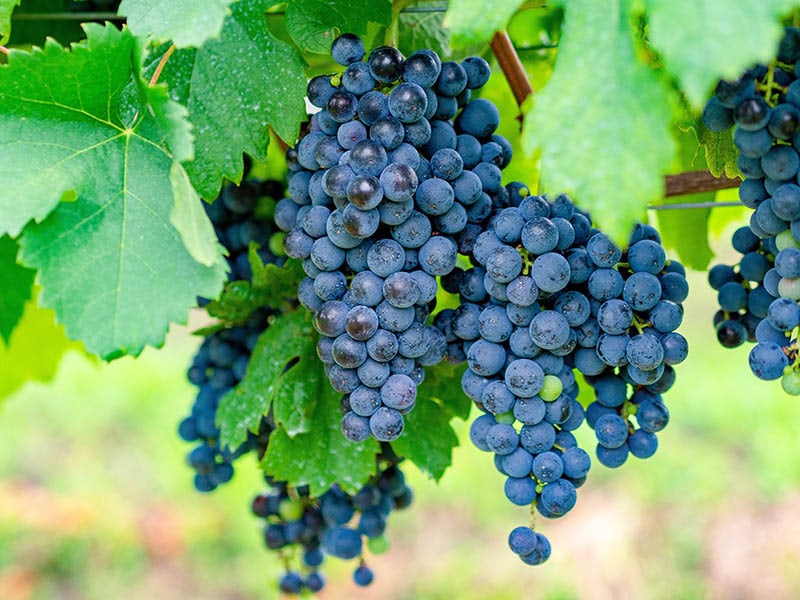
The word “Merlot” is inspired by the “merle”, which is the French word for a blackbird to refer to the black (or dark blue) skin of this grape.
Thanks to their fruitiness and softness, these Merlot grapes are ideal for blending with Cabernet Sauvignon, which has more tannin to cause bitterness. On the other hand, Merlot is also one of the most significant grapes to make the Bordeaux wine.
Overall, Merlot is the early-ripening grape with thinner skins that you can find the majority of them in the South of France. This variety is a well-known wine grape in Italy, Mexico, Chile, Australia, California, and more.
Season: Harvested from September through October
Location: France (primarily), Italy, Australia, Chile, Mexico, the USA, etc.
25. Gamay
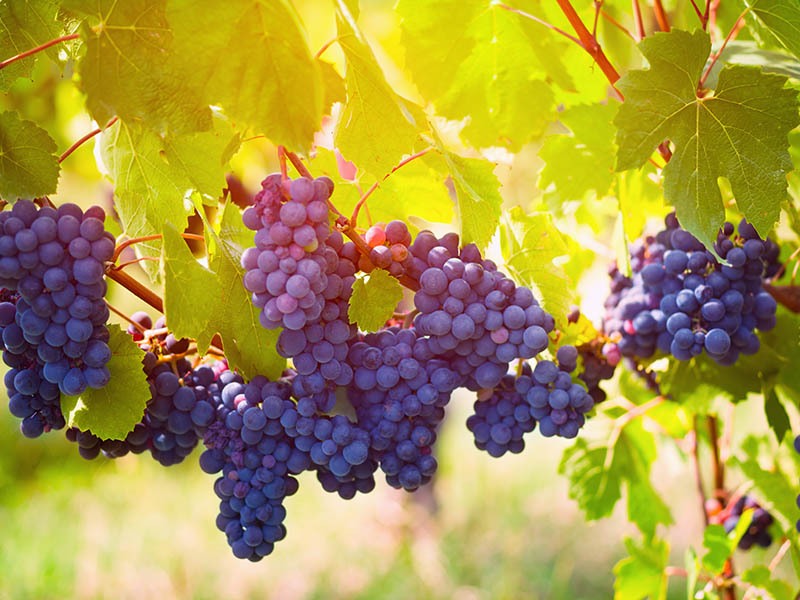
Gamay grapes are a purple-colored type that you can find in the ingredients of notable wines like Beaujolais nouveau or Bourgogne Passe-Tout-Grains. The full name of this variety is Gamay Noir à Jus Blanc.
Its long history starts in Gamay village (located in South France), where this famous type of grape is believed to have appeared in the 1360s. They have candy-like aroma, fruity flavor, and relatively high acidity that can create deep and complex-flavored wine.
Besides the French, people in Canada, Australia, or other countries also cultivate Gamay grapes to make their special wines.
Season: Harvested from September to October
Location: Mostly in France, Canada, Australia, or California
26. Malbec
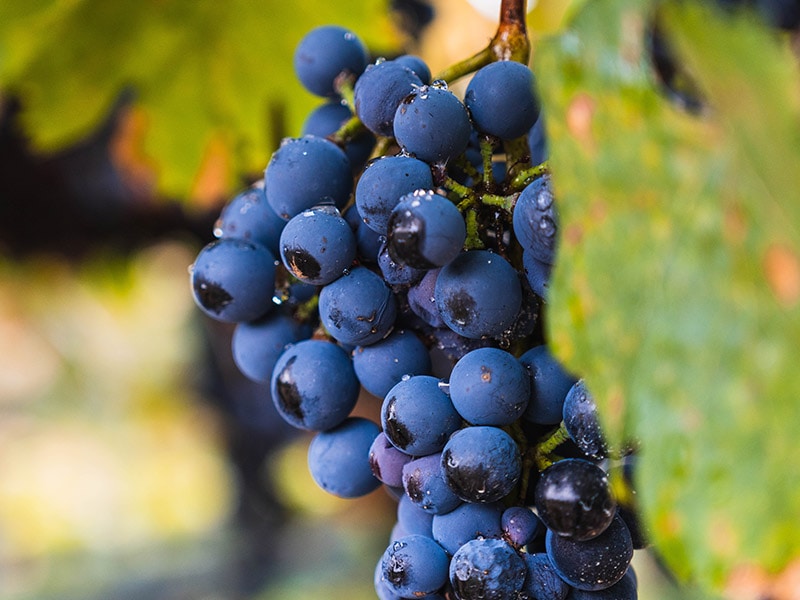
Malbec originates from France. With a sip of Malbec wine and some mouthwatering French cooking recipes, they can transport you to this beautiful country from your kitchen.
You can mostly find them in South West France, particularly in Cahors. They are cultivated around the world too, but in Argentina’s culinary world, Malbec has become the national grape to make Argentine wine.
Their skin color is blackish-purple, creating the most stunning red-colored wine. The best environment for them to thrive is under full sun.
People also mix Malbec grapes with other types of grapes to produce different wines. For example, the combination of Cabernet Sauvignon, Malbec, and Merlot is the best for making the red Bordeaux-style Red Blend wine with deep and powerful flavors.
Season: Usually from early March to harvest
Location: Argentina (mainly), France, the United States
27. Carménère
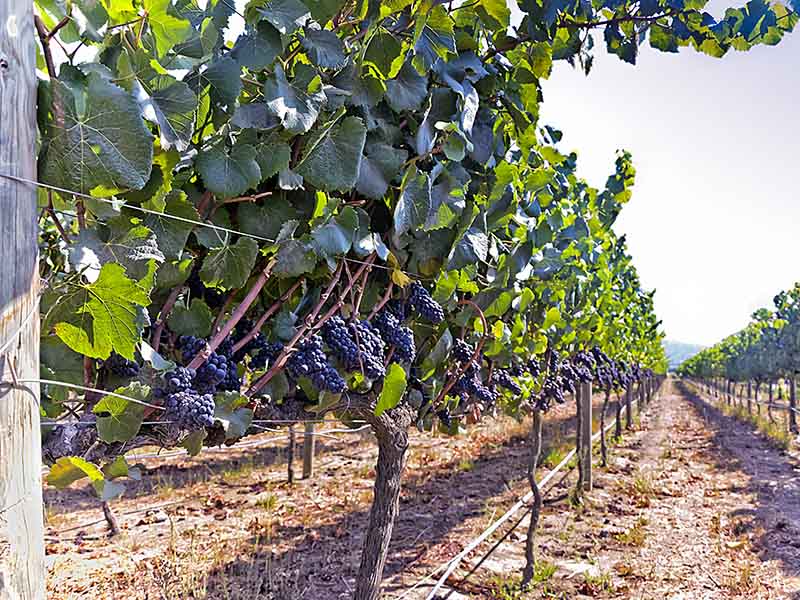
The last wine grape is Carménère with its origin from Bordeaux in France. However, it is now more likely to be found in Chile, Italy, the United States, and Argentina. In general, this is one of the most ancient grapes in European cultivars.
Carménère has dark skin, which is ideal for making red wine. This type needs a warm climate to fully develop and produce beautiful deep-red wine. Most wines made from these grapes have raspberry, cherry, and green peppercorn hints with a light bitter taste.
Season: Until mid-May for harvesting
Location: Chile (in the Central Valley), Italy, California, and Argentina
It is time to learn a bit about the heaven-sent Carménère grapes and the wines made from them.
Types Of Grapevine Leaves
You just have learned about 2 main grape types like table and wine grapes as above. But when it comes to grapevines, particularly grapevine leaves for easier recognition, they can be divided into 3 types, including Fox grape, Riverbank grape, and Summer grape.
Overall, grape leaves have heart-shaped appearances with many lobes. And the best way to differentiate them from each other is by their specific shapes and sizes. So here are some key appearance characteristics of these 3 types of grape leaves.
Fox Grapes (Vitis Labrusca)
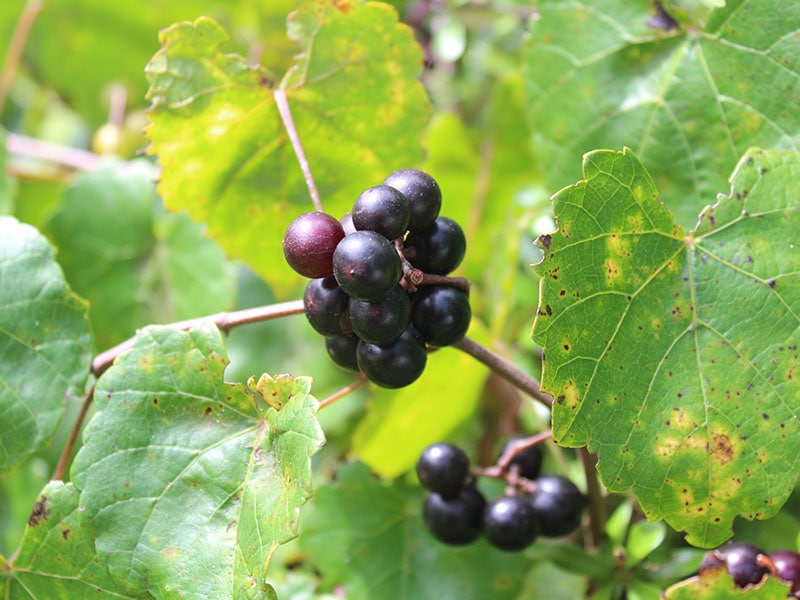
Fox grapes’ leaves have shallow lobed shapes and long forms. They can range from 4 to 8 inches in length.
Riverbank Grapes (Vitis Riparia)
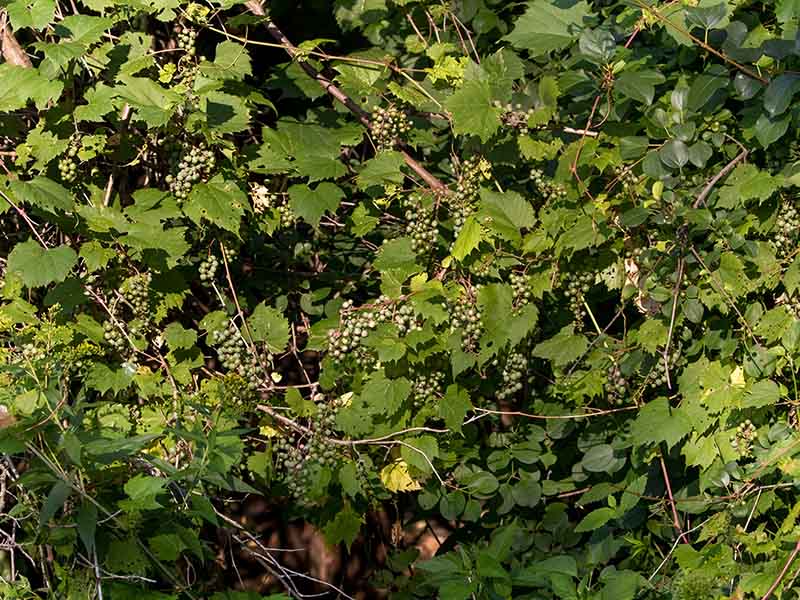
Similar to Fox grape types, these Riverbank varieties also have lobed leaves with a mostly heart-shaped form. However, their length is shorter, which is only up to 6 inches.
Summer Grapes (Vitis Aestivalis)
The biggest difference between these varieties and others is they have deep-lobed leaves. And they can be from 3 to 8 inches long.
But remember, not all grape leaves are edible. If you want to make stuffed dishes with grape leaves, the best one to go with is the Thompson Seedless. They are a perfect ingredient for your wonderful side dish from Greece named Dolmade (Dolma). I am sure you will devour them quickly!
How Was Your Experience With These Grapes?
Indeed, grapes contain various important nutrients to improve human health. Therefore, they are always the favorite fruit of many health-conscious people. But which type is your best-liked one to enjoy with your family?
Or which grape variety do you choose to make wine with? Please let me know your opinion in the comment section. Do not forget to share this post with your friends so they can learn more about these amazing fruits. Thank you!
